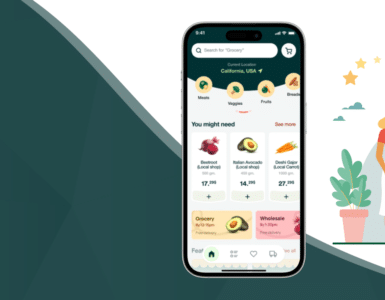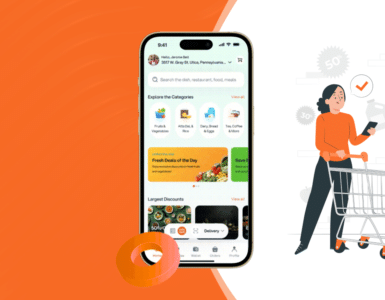Keeping a fitness app on your smartphone is standard practice today. With growing awareness about health and wellness, people are becoming more health-conscious and adopting digital tools to track and enhance their fitness routines. Fitness apps offer valuable insights that help users improve their workout regimes and overall lifestyle.
If you’re considering fitness app development, now is the ideal time. The global fitness app market is expected to reach USD 30 billion by 2030, making it a lucrative space for innovators and entrepreneurs. If you can build a user-centric, feature-rich app, you’ll likely see success sooner than expected.
Let’s walk through the types of fitness apps, the development process, and the must-have features you should include to create an exceptional fitness solution.
Types of Fitness Apps
Before reaching out to a mobile app development company, it’s crucial to decide what kind of fitness app you want to create. Here’s a breakdown of the most popular types of fitness apps:
1. Activity Tracking Apps
These apps help users monitor physical activities such as walking, running, cycling, or even sleep patterns. Some apps are activity-specific—for example, apps like Strava for cyclists and runners. Core functionalities include:
-
Step counting
-
Distance tracking
-
Calories burned
-
Heart rate monitoring (when connected to wearables)
2. Nutrition and Diet Apps
Nutrition-focused apps help users track food intake, count calories, and set diet goals. Users log their meals, and the app provides nutritional analysis. To boost engagement, consider adding:
-
Water intake tracking
-
Barcode scanner for packaged foods
-
Integration with government-approved nutritional databases for accuracy
3. Workout and Training Apps
These apps function as virtual personal trainers, offering tailored workouts for strength training, weight loss, or flexibility. Users can:
-
Select target areas (e.g., core, upper body, full body)
-
Customize routines based on their goals
-
Follow pre-recorded or live video sessions
Apps like Nike Training Club and FitOn are great examples.

Step-by-Step Guide to Fitness App Development
Now that you understand the app categories, let’s look at the development process.
1. Choose a Monetization Model
Your app’s revenue model should align with its features and target audience. Popular monetization options include:
-
In-app purchases (e.g., premium workouts or meal plans)
-
Subscription-based models
-
Freemium access (free basic features with paid upgrades)
-
Ad-supported content
-
Paid downloads
For more guidance, check out this in-depth fitness app development guide.
2. Define Core Features
Start with a Minimum Viable Product (MVP). Include essential features such as:
-
User registration
-
Profile management
-
Workout tracking
-
Nutrition logging
-
Notifications
-
Social sharing
We’ll dive into these features more in the next section.
3. Hire a Skilled App Development Team
Even if you have a great idea, execution matters. Partner with a reliable development team that understands your vision and market dynamics. They’ll help you build scalable architecture, intuitive UI/UX, and robust backend systems.
4. Build for Both iOS and Android
To reach a wider audience, ensure your app is available on both platforms. Your core team should include:
-
iOS Developer
-
Android Developer
-
Backend Developer
Cross-platform frameworks like Flutter or React Native can help streamline the process.
 Essential Features to Include in Your Fitness App
Essential Features to Include in Your Fitness App
To create a compelling and user-friendly experience, make sure to integrate these high-impact features:
Seamless Signup and Login
Keep the onboarding process simple. Offer multiple login options such as:
-
Social media login (Facebook, Google, Twitter)
-
Email or phone number
-
Biometric authentication for quick access
A smooth start improves retention.
Social Media Integration
Users love sharing fitness progress. Enable easy sharing of:
-
Workout summaries
-
Achievements (like steps taken or weight loss milestones)
-
Progress photos
This helps with organic growth through user referrals and online buzz.
Personalized User Profiles
Allow users to create detailed profiles that store:
-
Age, height, weight, and gender
-
Fitness goals
-
Preferred workout style
-
Previous activity history
Cloud synchronization enables cross-platform usability and better AI-driven personalization.
Activity and Progress Tracking
One of the most valued features, activity tracking should cover:
-
Steps, calories burned, and distance
-
Workout history
-
Integration with wearables (like Fitbit, Apple Watch, etc.)
Apps like Google Fit and Apple Health can serve as integration benchmarks.
Push Notifications and Reminders
Well-timed push notifications help:
-
Motivate users to stay consistent
-
Remind them of workouts or hydration
-
Announce challenges, updates, or new features
However, avoid spamming. Let users customize notification frequency for a better experience.
Final Thoughts
The digital fitness industry is booming, and users are seeking more personalized, intuitive, and insightful apps. If you’re planning to launch a fitness app, understanding the market demand, selecting the right app type, and incorporating must-have features is key.
Follow the above steps and work with a trusted mobile app development partner to turn your idea into a scalable, high-impact solution.
Whether it’s helping users shed pounds, build strength, or eat better — your fitness app could be the next game-changer in the health-tech space.
























